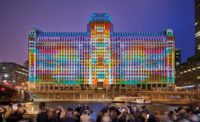Equating the role of the artist’s hand in traditional techniques, like woodworking or sculpting, to modern innovations like 3D printing, digital knitting, or CNC-milling, might seem antithetical to some. But a show now open at New York City's Museum of Arts and Design (MAD) argues that, though these pieces are not “handmade,” the creator’s touch is present throughout. Organized by Ronald T. Labaco, MAD’s Marcia Docter Curator, Out of Hand: Materializing the Postdigital is a highly successful attempt to capture this particular moment in the constantly evolving world of digital fabrication.
The exhibition features new and recent work from 2005 to the present and includes interactive installations and more than 120 digitally fabricated works of sculpture, jewelry, fashion, and furniture by 85 artists, architects, and designers, including Richard Dupont, Ron Arad, Chuck Close, Zaha Hadid, Anish Kapoor, Maya Lin, Marc Newson, Frank Stella, and others. “Part of the museum’s mission is dissolving the traditional boundaries between disciplines, so as you go through this exhibition, works of art are placed adjacent to design and architecture,” says Labaco. “There is no hierarchy.”
Three floors of galleries in the museum are dedicated to the show, including a hands-on lab on the second that displays 3D printers, scanners, and computer monitors, some of which are beautiful objects themselves. Designers-in-residence working in the gallery demonstrate digital techniques and fabrication tools, and a range of workshops will be held throughout the show’s run. Interactive components and video clips explain individual artistic practices. “The museum’s interest is in making, and in process, and we wanted to showcase this as a process of today,” says Labaco.
The show extends to the sidewalk in front of the museum where a 15-foot-tall cast aluminum sculpture represents a digitally-scanned mask of artist Richard Dupont’s face. A digitally-milled sculpture of wrestling figures by Michael Rees sits on an adjacent traffic island. Dupont’s piece, placed prominently in front of the building, “appropriately represents most works in the show” says Labaco, “because of its multi-stage process.”
The show is divided into six themes, though many pieces overlap across categories. One of the strongest is “Modeling Nature,” which includes pieces relating to biology or ecology such as Nervous System's delicate 3D printed lamps or Zaha Hadid's and Patrick Schumacher's Liquid Glacial Coffee Table, which incredibly captures a vortex of water frozen in polished Plexiglas.
Inside of the galleries the exhibition designers, New York City-based Inc Architecture & Design, simulated its idea of a virtual world with matte black walls, spot-lit exhibits, and CNC-milled modular Lucite bases. “We wanted the visitor and the non-virtual, fabricated objects to feel immersed within the virtual space of their development,” says Adam Rolston, partner with Inc Architecture & Design. “The black wall color is used to evoke that virtual, neutral space within the computer.” The concept succeeds—displays seem to be floating in a void that visitors enter as they step off of the elevator.
The large number of pieces in the exhibition was a challenge for both the curator and exhibition designers. Labaco chose to represent architecture—such as the Metropol Parasol in Seville, Spain, by J. Mayer H. Architects—with video installations rather than models or drawings, a decision he knows might not sit well with everyone. “I wanted to show that these were produced,” he says.
Labaco hopes that the exhibition will dispel any misconceptions, by artists and the public, about the artistic process involved in digital works. “Some practitioners feel that because it’s digital there may be the perception that it’s not coming out of the artist, that somehow there is a degree of distance,” says Labaco. “I believe that as you go through this exhibition, you will see that is not the case.”
Out of Hand will be on view through July 6, 2014.




















Post a comment to this article
Report Abusive Comment